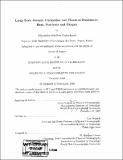Large scale oceanic circulation and fluxes of freshwater, heat, nutrients and oxygen
Author(s)
Ganachaud, Alexandre Similien, 1970-
DownloadFull printable version (38.51Mb)
Other Contributors
Woods Hole Oceanographic Institution.
Advisor
Carl Wunsch.
Terms of use
Metadata
Show full item recordAbstract
A new, global inversion is used to estimate the large scale oceanic circulation based on the World Ocean Circulation Experiment and Java Australia Dynamic Experiment hydrographic data. A linear inverse "box" model is used to combine consistently the transoceanic sections. The circulation is geostrophic with an Ekman layer at the surface and oceanic layers defined by neutral surfaces. Near-conservation of mass, salt and top-to-bottom silica is required and, in addition, heat and the phosphate-oxygen combination (170[PO 4]+[0 2]) are conserved in layers that are not in contact with the surface. A globally-consistent solution is obtained for a depth-independent adjustment to the thermal wind field, freshwater flux divergences, the Ekman transport, and the advective and diffusive dianeutral fluxes between layers. A detailed error budget permits calculation of statistical uncertainties, taking into account both the non-resolved part of the solution and the systematic errors due to the temporal oceanic variability. The estimated water mass transports during the WOCE period (1985-1996) are generally similar to previous published estimates. However, important differences are found. In particular, the inflow of bottom waters into the Pacific Ocean is smaller than in most previous estimates. Utilization of property anomaly conservation constraints allows the estimation of significant dianeutral diffusivities in deep layers, with a global average of 3 ± 1cm 2 s-1 north of 30'S. Dianeutral transfers indicate that about 20 Sv of bottom water is formed in the Southern Ocean. Significant oceanatmosphere heat fluxes are found, with a global heating of 2.3 ± 0.4 PW in the tropical band and a corresponding cooling at high latitudes. The signature of a large-scale average export production is found for nutrients in several temperate regions. Despite the large uncertainties, the production magnitudes are consistent with independent measurements from sediment traps and isotopic data. Net nutrient sources or sinks are found in several regions, suggesting either transport of dissolved organic matter or a seasonal alias. Oxygen indicates large exchanges with the atmosphere, with intake at high latitudes and outgassing/remineralization at low latitudes.
Description
Thesis (Sc. D.)--Joint Program in Physical Oceanography (Massachusetts Institute of Technology, Dept. of Earth, Atmospheric, and Planetary Sciences; and the Woods Hole Oceanographic Institution), February 2000. Includes bibliographical references (p. 250-266).
Date issued
2000Department
Joint Program in Physical Oceanography; Woods Hole Oceanographic Institution; Massachusetts Institute of Technology. Department of Earth, Atmospheric, and Planetary SciencesPublisher
Massachusetts Institute of Technology
Keywords
Joint Program in Physical Oceanography., Earth, Atmospheric, and Planetary Sciences., Woods Hole Oceanographic Institution.